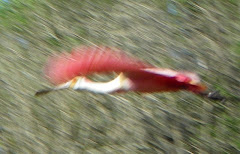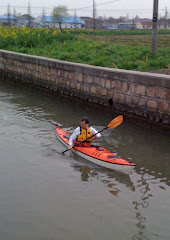Kayaking Misool Indonesia
When Nick invited me to guest
guide somewhere warm last winter, Indonesia was not on my radar. True
as a student I had been fascinated by Borneo, but that was years ago, before
the internet and the web, when I imagined Borneo as inhospitable with head
hunters who might want me for more than my managerial skills. But Borneo is a
thousand miles from West Papua, the part of Indonesia where Nick kept his
kayaks.
 |
| A dugout canoe floats beside houses on stilts |
I searched for a map of Misool, for
tourist information, for anything about Misool on the web, and found very little,
except for some glowing references to the richness of the underwater wildlife.
I learned about fish and corals, but little above water level. I failed to find a map to take.
Agreeing to go, I placed myself very
much in Nick’s hands and those of his Indonesian kayak guides. With no
definitive map, the place names we used were the names Nick had come up with
for his own reference. If I needed more, I’d have to make them up.
Nick is an explorer, happy to push
his way through thorny jungle fending off dengue fever and malaria, tackling
mosquitoes with a machete and a tough skin. He rarely pauses except to wonder
what lies over there, before going to find out. He visited some amazing places,
then his globe-trotting paused here when he realized its great kayaking
potential.
Nick established his company,
Millekul Adventures, to introduce adventurous people into places like this.
Here the fantasy land of Christmas tree shaped rock stacks and Tolkienesque
mazes, with hilltop viewpoints and ancient references seemed perfect for his
needs. Except with few possible places to stay, and with any rare hidden
beaches which might otherwise offer camping guarded by local clans, he set
about meeting people and learning.
From Sorong in West Papua we caught
the Express Ferry direct to the Raja Ampat island Misool. It
was early in the year, the ferry crowded with passengers and loaded with cargo
that had been carried on board by hand across the decks of two ships moored
between the ferry and the quay. The only respite from humid heat was a small
back deck, from which we watched the wake reveal where we had been.
We scrambled ashore at a village on
Misool, passing bags and supplies hand to hand along our human chain to pile
them on the wooden dock, a place alive with children and adults alike carrying
boxes of goods away as soon as they were thrown down from the high deck of the ferry.
Wooden walkways led from the dock into the town, a maze of small houses on
stilts above the shallows. Outriggers and dugouts floated or wallowed awash
underneath. Our boatmen methodically loaded all our supplies in just a few
minutes, and we climbed down into a long, narrow blue and red painted boat.
Speeding away, we were soon soaked to the skin in salt spray as the daylight
faded. Our destination was the island where Nick had his Whisky16 kayaks.
Impressions of Misool soon
overloaded my senses. There was the heat and humidity, day and night, coral
beaches and turquoise seas, rainbows, the call of strange birds. There were
turtle tracks up the beach and an intimidating northern cassowary. In the
evening the wonderful flavor of unfamiliar fish cooked with spices from nearby
islands. Such spices in Europe once cost more than their weight in gold.
As the kayaking trip unfolded there
was the karst scenery, towering islands of grey limestone so eroded by the
carbonic acid in rainwater that every edge of the pocked surface had been honed
sharp as a blade, every finger-hold like a needle.
Tucked into the myriad rock pockets
and holes were plants, leathery green leaves of orchids in flower, and pitcher
plants dangling down the faces.
 |
| Karst landscape presents a Tolkeinesque maze of rocks and islands |
Coconut palms broke the skyline between
the crags, mangrove trees flirted along the sheltered shallow water edges.
Corals teemed with fish in the warm water above wave-cut platforms, and deep
sinkholes dropped into clear dark blue.
We cruised the lagoons,
rocks and shoals, with the helicopter beat of hornbills and the shriek of
sulphur-crested parakeets resounding from the canopy of the jungle-clad slopes.
Camping where Nick had
negotiated permission, we strung lines and set mesh tents onto palm fronds on
the sand beneath lightweight tarps. Every lunch break offered an opportunity to
snorkel in the clear water with the corals and tropical fish. Occasionally we
saw a temporary fishing camp with dugout canoes, and long narrow fishing boats with
outboards.
 |
| Fishing camp with tarps over tied bamboo frames full of curious children |
The fishermen had tied
bamboo frames to spread with tough blue tarps to make shelter for boarded
sleeping platforms. Threatened by a sudden tropical downpour, we were ushered
to shelter with the opportunity to meet locals.
Misool, along with Papua and many
small islands, sits on the Australian continental shelf. Across a deeper
channel to the west, Sumatra, Java and Borneo rest instead on the Asian
continental shelf. Darwin’s contemporary, Alfred Russel Wallace, the man who
independently came up with a theory of evolution of species, had in the
mid-1800s recognized how deeper water between the continental shelves created a
barrier to fauna. There was a dividing line between species of animals in the
two regions.
The line he defined, the Wallace Line, is where he saw species
change from Asian to Australian. On the Asian side were monkeys and tigers, on
the other marsupials such as wallabies and cuscus. The islands between had a
slight mixing where some species had presumably swum from the mainland.
But if
there was one creature that we spotted more often than another it was the
ubiquitous land crab. The largest of all land crabs is the
coconut crab, Birgus latro. It might easily have been named the
coconut crab because of its size. It is large. On the other hand, it has been
seen to climb coconut trees dragging a coconut behind it to let it drop to the
ground to break it. It also has a powerful claw that can de-husk, open and
shred a coconut. Coconut crabs can fall from a tree from 15 feet with no
apparent harm.
 |
| Torleif bravely holds a coconut crab |
Another name by which Birgus latro is known is the robber crab, so besides avoiding trees with
falling coconuts and crabs, it’s always good to keep an eye on your belongings
and to close your tent zipper. That’s not only to discourage unwelcome guests,
whether mosquito or sheltering land crab, but also because a large land crab
can and will, as Brigitte discovered, drag away quite large items such as a nylon
pack full of goodies.
Sitting on the edge of the
Australian continental shelf, this area has surely been visited if not peopled
for thousands of years. During the last ice age people could have walked here
from what is now Australia. Pictographs survive on the cliffs, scribed in red,
dating back 2-5,000 years, protected by overhangs from erosion.
 |
| Pictoraphs adorn sea cliff walls beneath overhangs |
Beneath overhangs there’s a visible
difference from the sharp-edged karst. It's the mildly acidic rainwater that slowly
eats away at the exposed rock surfaces and carries away the limestone as soluble
calcium bicarbonate, leaving all the sharp edges. The calcium bicarbonate
solution drains away through cracks in the rock to drip from the roof of
overhangs, but before dripping, the water degases, freeing carbon dioxide from
the calcium bicarbonate and depositing calcium carbonate before the water
drips. These deposits build into long stalactites, curtains and organ-pipe
formations, smooth as silk with no sharp edges.
 |
| Sea caves and land caves riddle the islands with holes |
Of course, water not only drips from
overhangs, it also flows together into bedding planes in the rock creating
streams that gouge out tunnels and caverns. The rock here is riddled with such
tunnels, both miniature and mighty. Exploring caves by kayak and on foot it
became evident that each limestone island has become eroded into something
like a sponge, full of holes and tunnels. But whereas the outer surfaces of the
islands are hot and menacing with sharp edges that can cut skin, the insides
are cooler, contoured, smooth and forgiving.
Our journey eventually carried us
from a sea bursting with shoals of jumping fish, and rained upon by frigate
birds, up into a jungle river as far as we could go. From our highest landing,
we explored along hunters’ tracks. Far beneath a canopy alive with birds we heard but seldom saw at ground level, we watched brilliant butterflies and tripped on fallen fruits we did not recognize. There were stout vines dangling
everywhere to swing Tarzan-like over the warm clear blue jungle streams.
 |
| Ascending a Misool jungle river as far as we could |
As night approached, there was the
clatter of hornbills flying in and crying from the high canopy, along with
tuneful calls from birds we couldn’t name. With the fast falling night came a
chorus of frogs and insects, the leathery wing-beats of fruit bats and the flit
of smaller bats catching mosquitoes or moths. Here and there we spotted the
rising star of a firefly lifting high between the trees, and on the ground the
bioluminescent glow from rotting vegetation.
Learn more about Misool from
Millekul Adventures, where you’ll find a short YouTube video of the kayaking.
If you’re interested to join me, Nigel Foster, I plan to paddle there again (contact Millekul Adventures) next January and early February. See you there?































































